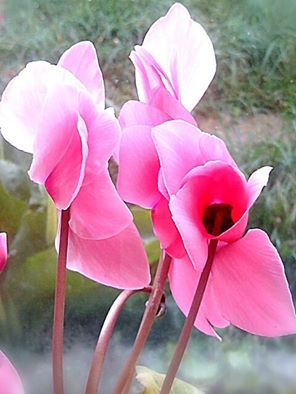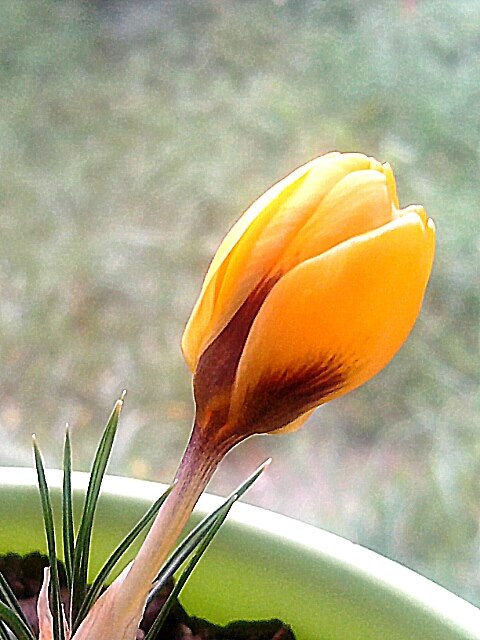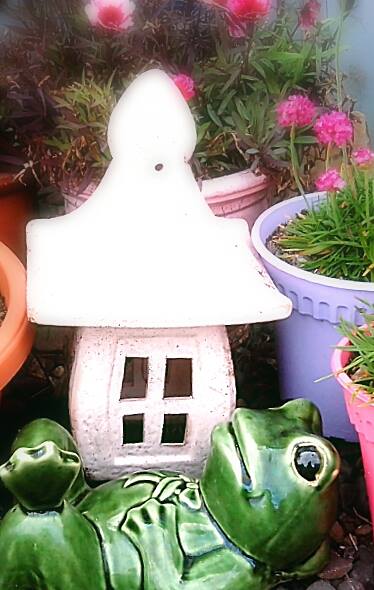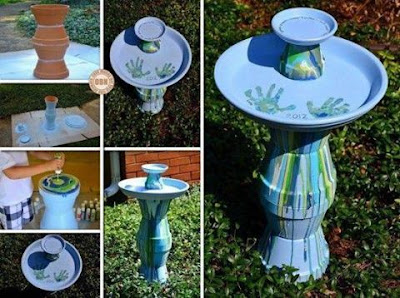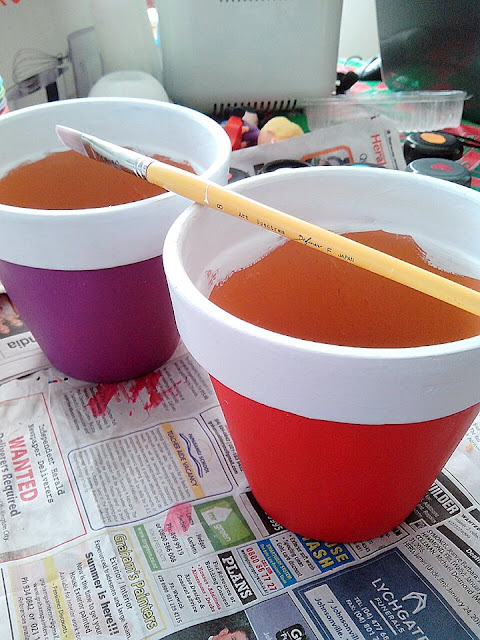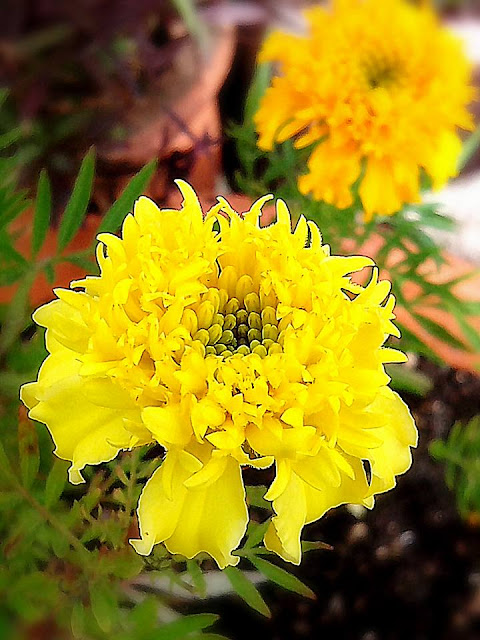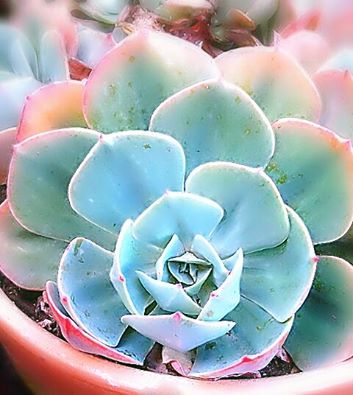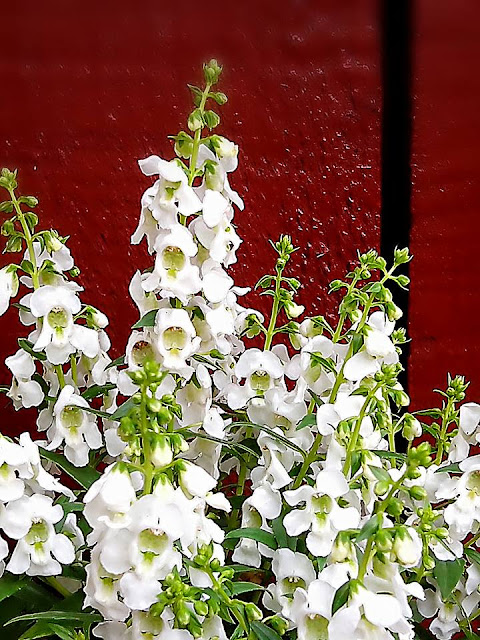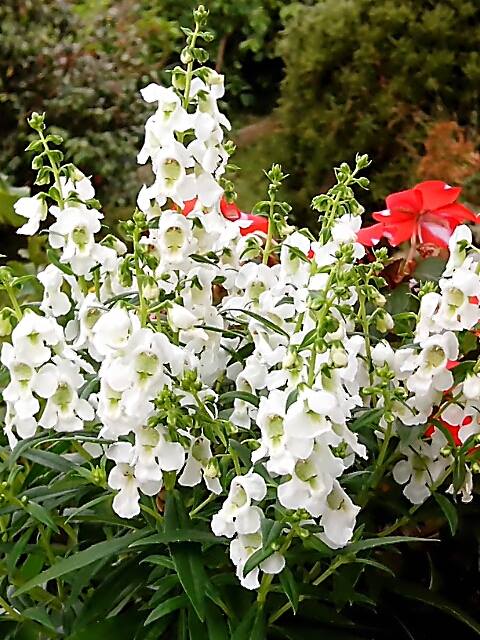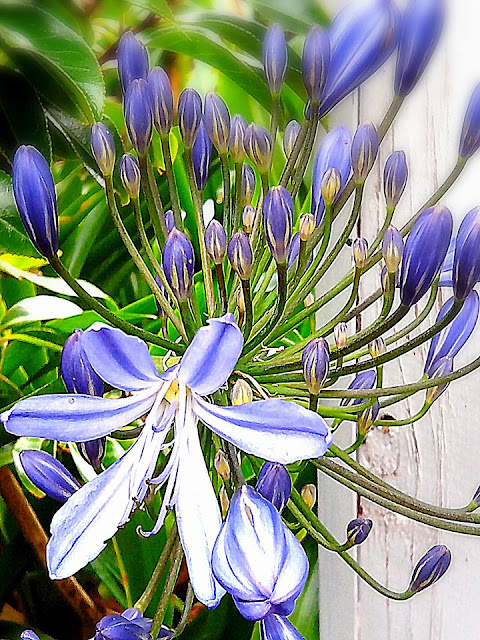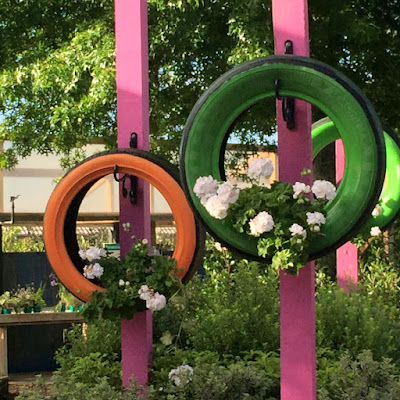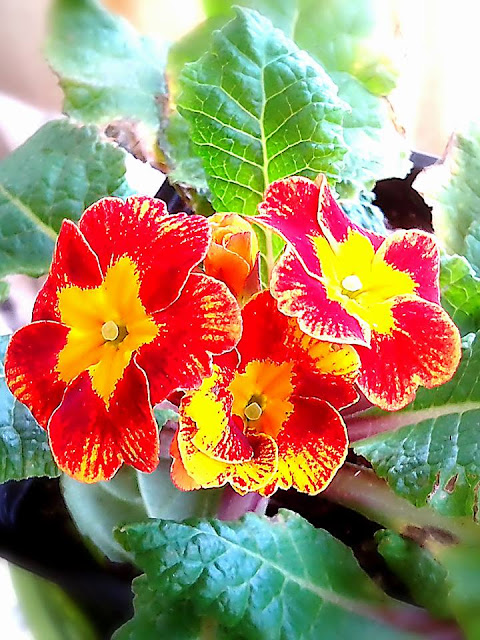Friday, October 14, 2016
Giant Cyclament
My pretty Giant Cyclamen that my mother in law gave it to me around three years ago. It doesn’t have the scent like the miniature one that I have.
Yellow Crocus
Hi, look, my yellow Crocus is blooming, she is so pretty, isnt it? Yellow is my favourite colour - Yellow always bright my days.
Have a great weekend, everyone.
Wednesday, April 20, 2016
Wednesday, February 17, 2016
My Sunny SunFlower
With the energy and golden glow of the sun itself, Sunflowers are the essence of Summer.
In bud or in bloom, Sunflowers are a Summer delight, don’t you think?
In bud or in bloom, Sunflowers are a Summer delight, don’t you think?
Just Relax
Sometimes you just need to go to that quiet place. Lay back, look up, and enjoy God’s presence.
Picture : the frog statue from my best friend years ago, my son calls it " Pangeran Katak " which is mean Prince Frog in English.
Flower Pot Bird Bath
DIY FLOWER POT BIRD BATH...this looks so much fun for the kids to make! via The Keeper of the Cheerios-Blog
http://www.inlieuofpreschool.com/homemade-flower-pot-bird-…/
Train Log Planter
TRAIN LOG PLANTER....this is such a fun idea! Love it!!
https://www.pinterest.com/pin/108719778482730032/
DIY Wishing Well
DIY WISHING WELL...made with Old Tires! This is such a fun Spring idea to plant flowers in!
https://www.pinterest.com/pin/108719778482741979/
If You Like Colours
Have you tried to combinations of paint and plant colours ? I find it more fun than I could have imagined.
So, get painting and planting.
It is smile inducing.
Lady in Blue
I was looking for a plant which is perennial, evergreen, a lil bit tall, and has flowers, as a background. Then I found what I want, yeepeeeee :)
This is my Aster - Lady in Blue. I bought it in January 2016, when its price was down from $12 to $3, yes it’s a good buy. Nothing wrong with the plant, though !! just need to get a bigger pot, that’s all.
I am looking forward to see my Aster blooms. After blooming, I think it will need a haircut to freshen it up.
Wednesday, February 10, 2016
January To Do List For Roses
January To-Do List For Roses:
~ Roses that were fed at the end of winter or in early spring will need their second big feed in summer (January).
~ January is a good month for a summer prune. Cut back the once flowering roses because they need to be pruned now rather than in winter (?). The repeat bloomers can have a general tidy up ready for February flowers.
~ Check the base of roses to see if winds have rocked the bud union out of soil. A rose rocking on its roots is not happy so add more soil, tramp down firmly, and tie the rose to a strong stake if necessary.
~ Spray roses with skim milk and water - half and half - to discourage fungi like black spot and rust.
~ You can feed them at the same time by adding liquid fertiliser (seaweed or fish) to the mix.
~ Keep picking roses or deadheading to encourage the plant to keep on flowering.
Source : NZ Gardener
~ Roses that were fed at the end of winter or in early spring will need their second big feed in summer (January).
~ January is a good month for a summer prune. Cut back the once flowering roses because they need to be pruned now rather than in winter (?). The repeat bloomers can have a general tidy up ready for February flowers.
~ Check the base of roses to see if winds have rocked the bud union out of soil. A rose rocking on its roots is not happy so add more soil, tramp down firmly, and tie the rose to a strong stake if necessary.
~ Spray roses with skim milk and water - half and half - to discourage fungi like black spot and rust.
~ You can feed them at the same time by adding liquid fertiliser (seaweed or fish) to the mix.
~ Keep picking roses or deadheading to encourage the plant to keep on flowering.
Source : NZ Gardener
Purple Tin For Purple Flowers
This morning, when I was in the garden counting the rose buds, I saw my purple tin pot hanging on the branch. So I thought it is a good pot for putting the potted Bromeliad inside the purple tin. It goes with the colour of Bromeliad flower. It is nice, isn’t it?
Pure White
One day, there was a sale for Christmas Lily bulbs: just 50 cents each. Yes just FIFTY CENTS .
Because it was very late for planting Lilies, and I didn’t know much about Lily bulbs, I decided to buy two bulbs instead of 10 or more.
The seller said "Are you sure you just want two?". I smiled and said "Yes I am sure".
Now I know that I should have bought more than two bulbs. Oh well.....
Even though it was very late for planting, my Christmas Lily are healthy and they are blooming. They are not very tall, though. I am not sure if they are dwarf type or they are short because they were very late in planting. Pure white flower and smell like jasmine, I think.
Little Pinky
We went to Waitangi Celebration Day, and had a nice Hangi, the Maori’s traditional food.
Over there, there was a shop selling lots of Peace Lily plants, and just only one Daisy plant .So I bought the Daisy, of course, because I have’got Peace Lily at home.
My Double Pink - Daisy Plant.
Marigold Cupid Dwarf
I bought the packet of Marigold Cupid Dwarf Mixed seeds from Twigland Garden Centre. It contains approximately 125 seeds but I just planted 10 seeds for Summer 2016.
Marigold Cupid - a compact dwarf plant with large, softly curled flowers in yellow, gold, and orange.
Source : http://homeguides.sfgate.com/grow-marigold-seed-heads-66394.html
More than just a pretty flower, marigolds
protect your garden vegetables from unhealthy nematodes that cause
deformities and disease. Grown as an annual, marigolds are propagated by
sowing seeds in the spring. You can collect the seed heads after the
flowers are spent so you have fresh seeds for the following growing
season. The process of removing dead flowers from the plant is called
deadheading; it is beneficial because it promotes more flowering in the
plant. After you harvest the dead seed heads, there are a few things you
must do to ensure a healthy production of marigolds next year.
Collecting Seeds
1
Gather the dead seed heads from the marigold plants by cutting them from the plant with pruning shears or scissors. Spread the seed heads on a drying tray and set the tray in a shady area that has good ventilation. Allow the seed heads to dry completely before removing the seeds. This may take anywhere from seven to 10 days.2
Move the seed heads from the drying tray to a flat work surface. Firmly grip the dried petals of the seed heads and hold the bottom with your other hand. Pull the petals out of the dried receptacle. The parts that look like tiny black carrots are the seeds. Separate the seeds from the rest of the flower parts.3
Place the seeds in an airtight container and label the container with the date and variety of the marigolds. Store the container in a cool, dark place until six weeks before the growing season starts.Planting Marigold Seeds
1
Fill a propagation tray with a good quality potting soil. Moisten the soil completely and allow the tray to drain. Make evenly spaced holes about 1 inch apart in the planting medium. Remove the marigold seeds from storage and place two seeds in each hole. Cover the seeds with a fine layer of soil.2
Cover the tray with a clear lid or clear plastic film. Set the tray in a warm place that receives bright light. Use a grow light that is suspended about 6 inches above the tray if you do not have a bright window.3
Remove the tray lid or plastic film after most of the seeds have germinated. Thin the marigold seedlings to one healthy plant per space when the plants have their first set of true leaves.4
Leave the seedlings in the bright light and do not allow the soil to dry out while the seedlings grow. Avoid wet soil or the seedlings will suffer from stem rot. Rotate the tray every other day to promote even growth among the seedlings.5
Pinch off the top of the seedlings when the plants have at least four sets of leaves to promote bushy growth. When the marigolds are about 4 to 6 inches tall, start the outdoor acclimation process.Acclimation and Planting
1
Move the marigolds outdoors in a shady part of the garden for about an hour a day. Increase the amount of time in the garden every few days. Move the flowers into the sun gradually, moving the tray from shade to partial shade and finally into the full sun, as you acclimate the flowers.2
Water the marigolds from the bottom each morning to avoid sunburn and powdery mildew. Move the plants into the shade at the first sign of stress: wilting, drooping leaves or color change.3
Plant the marigolds in a prepared garden site that has been tilled to a depth of about 6 to 8 inches and amended with a layer of compost or other organic matter. Space the plants about 8 to 10 inches apart. Increase the spacing by 2 inches if you grow a large variety.In The Flesh
In the Flesh.
Succulents have developed fleshy leaves to store water, allowing them to survive for long periods without rain. They need a minimal amount of watering, and they can virtually cope without any attention whatsoever.
I have several kinds of succulents in my garden. This one here on the photo, I bought it from someone who had a garage sale last year. We happened to pass by on the way to the car. I spotted two bigs terracota pots. Two bucks each with some succulents in them as well. Woohoo !!!! What a bargain !!!
Monday, February 1, 2016
Pohutakawa's Flower
This is New Zealand Christmas Tree's or Pohutakawa's flower .
It 's not from my garden, my husband picked the flower when we had a picnic.
Actually there is a Pohutakawa tree in my garden but it hasn't had the flower yet.
Friday, January 29, 2016
Saturday, January 23, 2016
Pure White Angelonia
Sweet delicate flowers on the upright spikes.
This Summer Snapdragon is perennial and also very hardy.
I fall in love with my Angelonia Angelface White or Summer Snapdragon.
She is attractive to bees, birds, and butterflies,
Angelonia is the wind and the desease resistant plants for the windy garden, and perennial too.
Blooming in Summer time, but if you have a bright sunny spot indoor, you can even keep it flowering in Winter. Also you dont need to dead heading the flowers.
If
Angelonia plants begin to sprawl in midsummer, cut them back by about
half their height. They will soon regrow and produce a fresh flush of
flowers.
- See more at:
http://www.gardeningknowhow.com/ornamental/flowers/angelonia/growing-angelonia-plants.htm#sthash.R4J4Bg14.dpuf
If
Angelonia plants begin to sprawl in midsummer, cut them back by about
half their height. They will soon regrow and produce a fresh flush of
flowers.
- See more at:
http://www.gardeningknowhow.com/ornamental/flowers/angelonia/growing-angelonia-plants.htm#sthash.R4J4Bg14.dpuf
If
Angelonia plants begin to sprawl in midsummer, cut them back by about
half their height. They will soon regrow and produce a fresh flush of
flowers.
- See more at:
http://www.gardeningknowhow.com/ornamental/flowers/angelonia/growing-angelonia-plants.htm#sthash.R4J4Bg14.dpuf
If
Angelonia plants begin to sprawl in midsummer, cut them back by about
half their height. They will soon regrow and produce a fresh flush of
flowers.
- See more at:
http://www.gardeningknowhow.com/ornamental/flowers/angelonia/growing-angelonia-plants.htm#sthash.R4J4Bg14.dpufOld Tyre for Geranium
What to do with tyres...Spray paint and geraniums can work wonders.
( Photo from : Odering Garden Centre, NZ )
My Polyanthus in the Summer Time
Polyanthus starts flowering from early Winter, continue right through until Christmas.
Often treated as a plant with a short life span.
But my Polyanthus starts flowering in the middle of Summer, 23rd of January 2016.
Often treated as a plant with a short life span.
But my Polyanthus starts flowering in the middle of Summer, 23rd of January 2016.
Subscribe to:
Posts (Atom)


